Planning, Designing and Evaluating Health Interventions for Smoking Cessation
VerifiedAdded on 2023/06/14
|15
|5190
|355
AI Summary
This report discusses the planning, designing, and evaluating of health interventions for smoking cessation. It highlights the role of planning, integration of therapies, and stakeholder engagement in needs assessment. The report also covers the approaches to intervention design and evaluation strategy for smoking cessation. The theories of planned behavior, social cognitive theory, and psychoanalytic theory are discussed in detail. The subject of the report is Health, and the course code, college/university are not mentioned.
Contribute Materials
Your contribution can guide someone’s learning journey. Share your
documents today.

Planning, Designing and
Evaluating Health Interventions
1
Evaluating Health Interventions
1
Secure Best Marks with AI Grader
Need help grading? Try our AI Grader for instant feedback on your assignments.

TABLE OF CONTENT
INTRODUCTION ..........................................................................................................................3
Rationale:.....................................................................................................................................3
INTERVENTION DESIGN............................................................................................................8
Approaches to intervention design for smoking cessation..........................................................8
EVALUATION STRATEGY........................................................................................................10
Evaluation approaches to selected interventions for smoking cessation...................................10
CONCLUSION..............................................................................................................................13
REFERENCES..............................................................................................................................14
2
INTRODUCTION ..........................................................................................................................3
Rationale:.....................................................................................................................................3
INTERVENTION DESIGN............................................................................................................8
Approaches to intervention design for smoking cessation..........................................................8
EVALUATION STRATEGY........................................................................................................10
Evaluation approaches to selected interventions for smoking cessation...................................10
CONCLUSION..............................................................................................................................13
REFERENCES..............................................................................................................................14
2
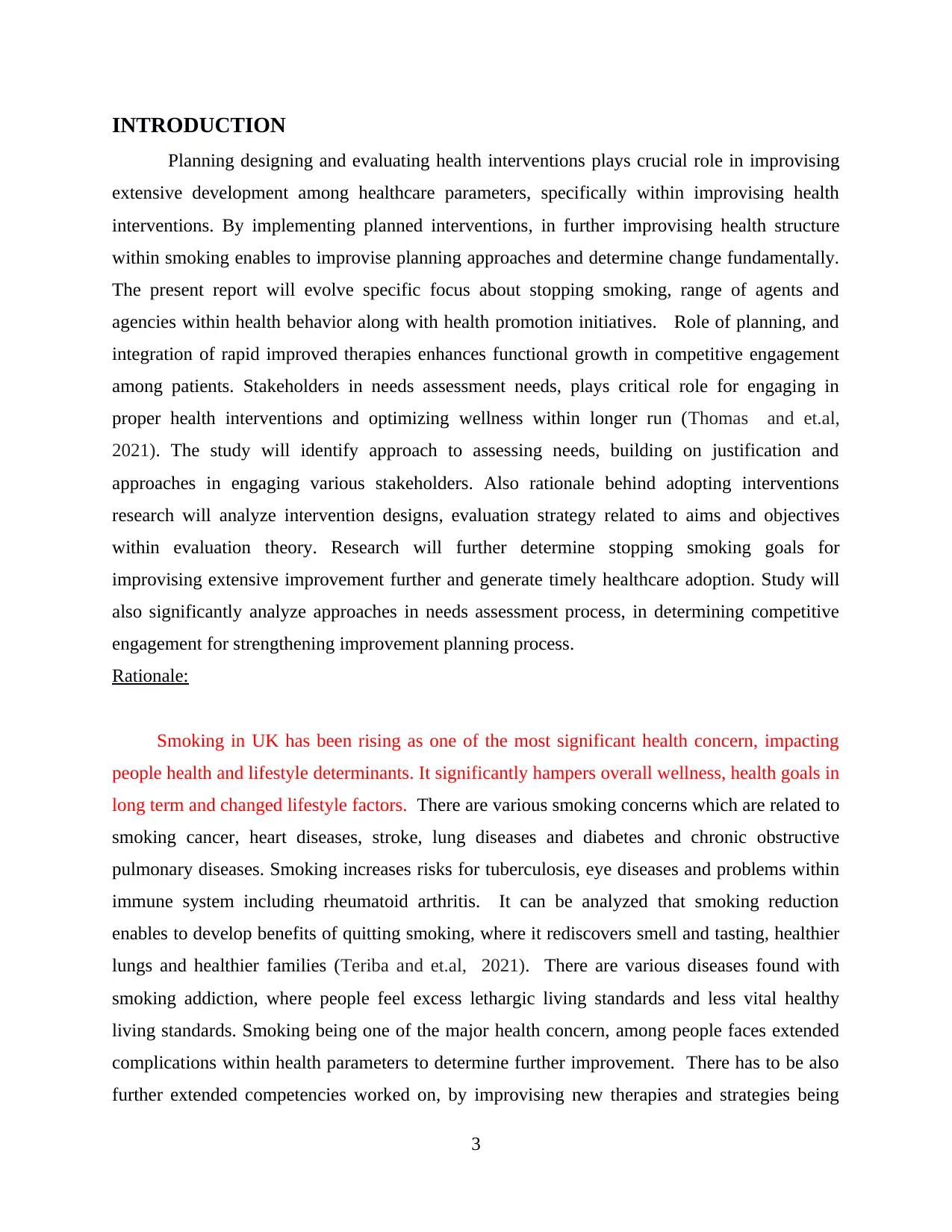
INTRODUCTION
Planning designing and evaluating health interventions plays crucial role in improvising
extensive development among healthcare parameters, specifically within improvising health
interventions. By implementing planned interventions, in further improvising health structure
within smoking enables to improvise planning approaches and determine change fundamentally.
The present report will evolve specific focus about stopping smoking, range of agents and
agencies within health behavior along with health promotion initiatives. Role of planning, and
integration of rapid improved therapies enhances functional growth in competitive engagement
among patients. Stakeholders in needs assessment needs, plays critical role for engaging in
proper health interventions and optimizing wellness within longer run (Thomas and et.al,
2021). The study will identify approach to assessing needs, building on justification and
approaches in engaging various stakeholders. Also rationale behind adopting interventions
research will analyze intervention designs, evaluation strategy related to aims and objectives
within evaluation theory. Research will further determine stopping smoking goals for
improvising extensive improvement further and generate timely healthcare adoption. Study will
also significantly analyze approaches in needs assessment process, in determining competitive
engagement for strengthening improvement planning process.
Rationale:
Smoking in UK has been rising as one of the most significant health concern, impacting
people health and lifestyle determinants. It significantly hampers overall wellness, health goals in
long term and changed lifestyle factors. There are various smoking concerns which are related to
smoking cancer, heart diseases, stroke, lung diseases and diabetes and chronic obstructive
pulmonary diseases. Smoking increases risks for tuberculosis, eye diseases and problems within
immune system including rheumatoid arthritis. It can be analyzed that smoking reduction
enables to develop benefits of quitting smoking, where it rediscovers smell and tasting, healthier
lungs and healthier families (Teriba and et.al, 2021). There are various diseases found with
smoking addiction, where people feel excess lethargic living standards and less vital healthy
living standards. Smoking being one of the major health concern, among people faces extended
complications within health parameters to determine further improvement. There has to be also
further extended competencies worked on, by improvising new therapies and strategies being
3
Planning designing and evaluating health interventions plays crucial role in improvising
extensive development among healthcare parameters, specifically within improvising health
interventions. By implementing planned interventions, in further improvising health structure
within smoking enables to improvise planning approaches and determine change fundamentally.
The present report will evolve specific focus about stopping smoking, range of agents and
agencies within health behavior along with health promotion initiatives. Role of planning, and
integration of rapid improved therapies enhances functional growth in competitive engagement
among patients. Stakeholders in needs assessment needs, plays critical role for engaging in
proper health interventions and optimizing wellness within longer run (Thomas and et.al,
2021). The study will identify approach to assessing needs, building on justification and
approaches in engaging various stakeholders. Also rationale behind adopting interventions
research will analyze intervention designs, evaluation strategy related to aims and objectives
within evaluation theory. Research will further determine stopping smoking goals for
improvising extensive improvement further and generate timely healthcare adoption. Study will
also significantly analyze approaches in needs assessment process, in determining competitive
engagement for strengthening improvement planning process.
Rationale:
Smoking in UK has been rising as one of the most significant health concern, impacting
people health and lifestyle determinants. It significantly hampers overall wellness, health goals in
long term and changed lifestyle factors. There are various smoking concerns which are related to
smoking cancer, heart diseases, stroke, lung diseases and diabetes and chronic obstructive
pulmonary diseases. Smoking increases risks for tuberculosis, eye diseases and problems within
immune system including rheumatoid arthritis. It can be analyzed that smoking reduction
enables to develop benefits of quitting smoking, where it rediscovers smell and tasting, healthier
lungs and healthier families (Teriba and et.al, 2021). There are various diseases found with
smoking addiction, where people feel excess lethargic living standards and less vital healthy
living standards. Smoking being one of the major health concern, among people faces extended
complications within health parameters to determine further improvement. There has to be also
further extended competencies worked on, by improvising new therapies and strategies being
3
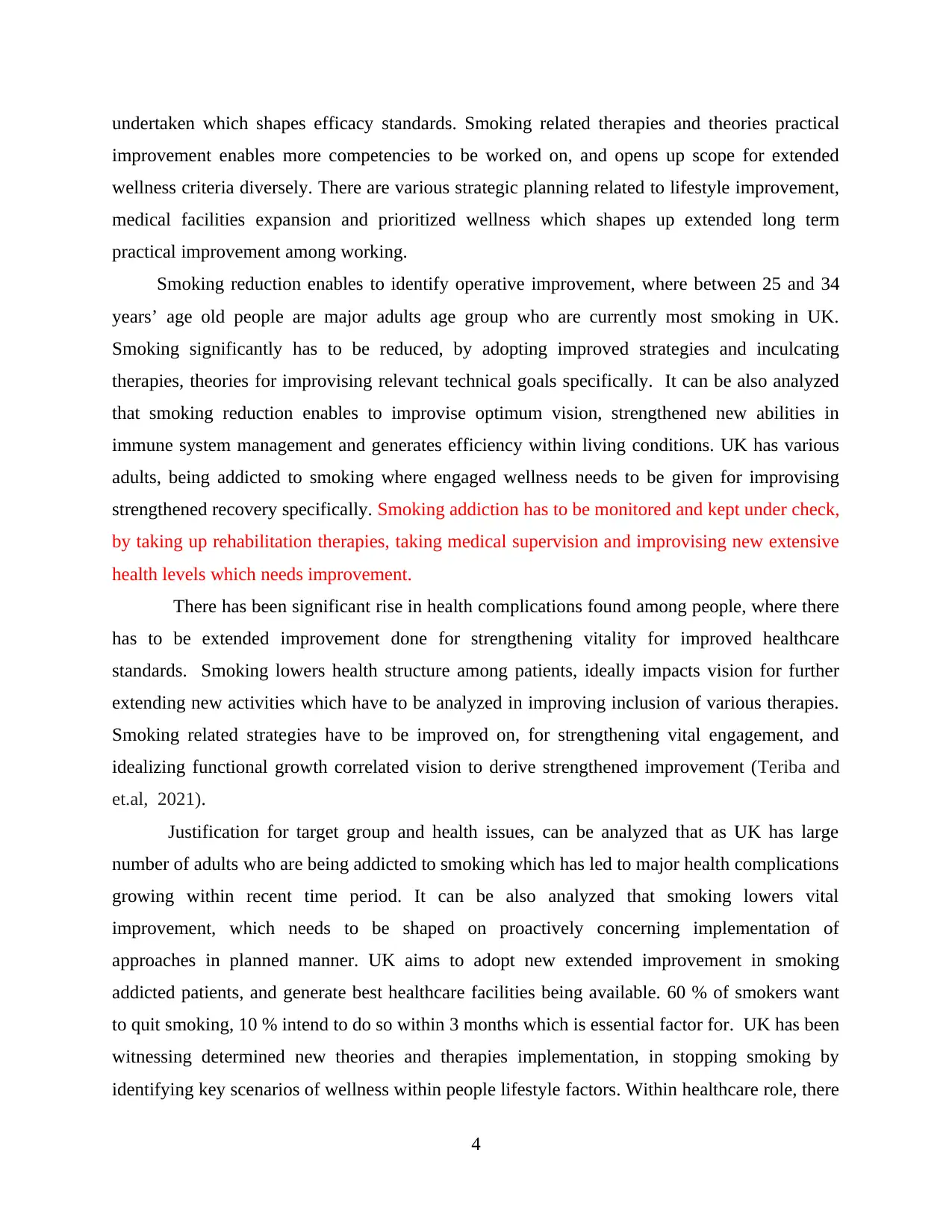
undertaken which shapes efficacy standards. Smoking related therapies and theories practical
improvement enables more competencies to be worked on, and opens up scope for extended
wellness criteria diversely. There are various strategic planning related to lifestyle improvement,
medical facilities expansion and prioritized wellness which shapes up extended long term
practical improvement among working.
Smoking reduction enables to identify operative improvement, where between 25 and 34
years’ age old people are major adults age group who are currently most smoking in UK.
Smoking significantly has to be reduced, by adopting improved strategies and inculcating
therapies, theories for improvising relevant technical goals specifically. It can be also analyzed
that smoking reduction enables to improvise optimum vision, strengthened new abilities in
immune system management and generates efficiency within living conditions. UK has various
adults, being addicted to smoking where engaged wellness needs to be given for improvising
strengthened recovery specifically. Smoking addiction has to be monitored and kept under check,
by taking up rehabilitation therapies, taking medical supervision and improvising new extensive
health levels which needs improvement.
There has been significant rise in health complications found among people, where there
has to be extended improvement done for strengthening vitality for improved healthcare
standards. Smoking lowers health structure among patients, ideally impacts vision for further
extending new activities which have to be analyzed in improving inclusion of various therapies.
Smoking related strategies have to be improved on, for strengthening vital engagement, and
idealizing functional growth correlated vision to derive strengthened improvement (Teriba and
et.al, 2021).
Justification for target group and health issues, can be analyzed that as UK has large
number of adults who are being addicted to smoking which has led to major health complications
growing within recent time period. It can be also analyzed that smoking lowers vital
improvement, which needs to be shaped on proactively concerning implementation of
approaches in planned manner. UK aims to adopt new extended improvement in smoking
addicted patients, and generate best healthcare facilities being available. 60 % of smokers want
to quit smoking, 10 % intend to do so within 3 months which is essential factor for. UK has been
witnessing determined new theories and therapies implementation, in stopping smoking by
identifying key scenarios of wellness within people lifestyle factors. Within healthcare role, there
4
improvement enables more competencies to be worked on, and opens up scope for extended
wellness criteria diversely. There are various strategic planning related to lifestyle improvement,
medical facilities expansion and prioritized wellness which shapes up extended long term
practical improvement among working.
Smoking reduction enables to identify operative improvement, where between 25 and 34
years’ age old people are major adults age group who are currently most smoking in UK.
Smoking significantly has to be reduced, by adopting improved strategies and inculcating
therapies, theories for improvising relevant technical goals specifically. It can be also analyzed
that smoking reduction enables to improvise optimum vision, strengthened new abilities in
immune system management and generates efficiency within living conditions. UK has various
adults, being addicted to smoking where engaged wellness needs to be given for improvising
strengthened recovery specifically. Smoking addiction has to be monitored and kept under check,
by taking up rehabilitation therapies, taking medical supervision and improvising new extensive
health levels which needs improvement.
There has been significant rise in health complications found among people, where there
has to be extended improvement done for strengthening vitality for improved healthcare
standards. Smoking lowers health structure among patients, ideally impacts vision for further
extending new activities which have to be analyzed in improving inclusion of various therapies.
Smoking related strategies have to be improved on, for strengthening vital engagement, and
idealizing functional growth correlated vision to derive strengthened improvement (Teriba and
et.al, 2021).
Justification for target group and health issues, can be analyzed that as UK has large
number of adults who are being addicted to smoking which has led to major health complications
growing within recent time period. It can be also analyzed that smoking lowers vital
improvement, which needs to be shaped on proactively concerning implementation of
approaches in planned manner. UK aims to adopt new extended improvement in smoking
addicted patients, and generate best healthcare facilities being available. 60 % of smokers want
to quit smoking, 10 % intend to do so within 3 months which is essential factor for. UK has been
witnessing determined new theories and therapies implementation, in stopping smoking by
identifying key scenarios of wellness within people lifestyle factors. Within healthcare role, there
4
Secure Best Marks with AI Grader
Need help grading? Try our AI Grader for instant feedback on your assignments.
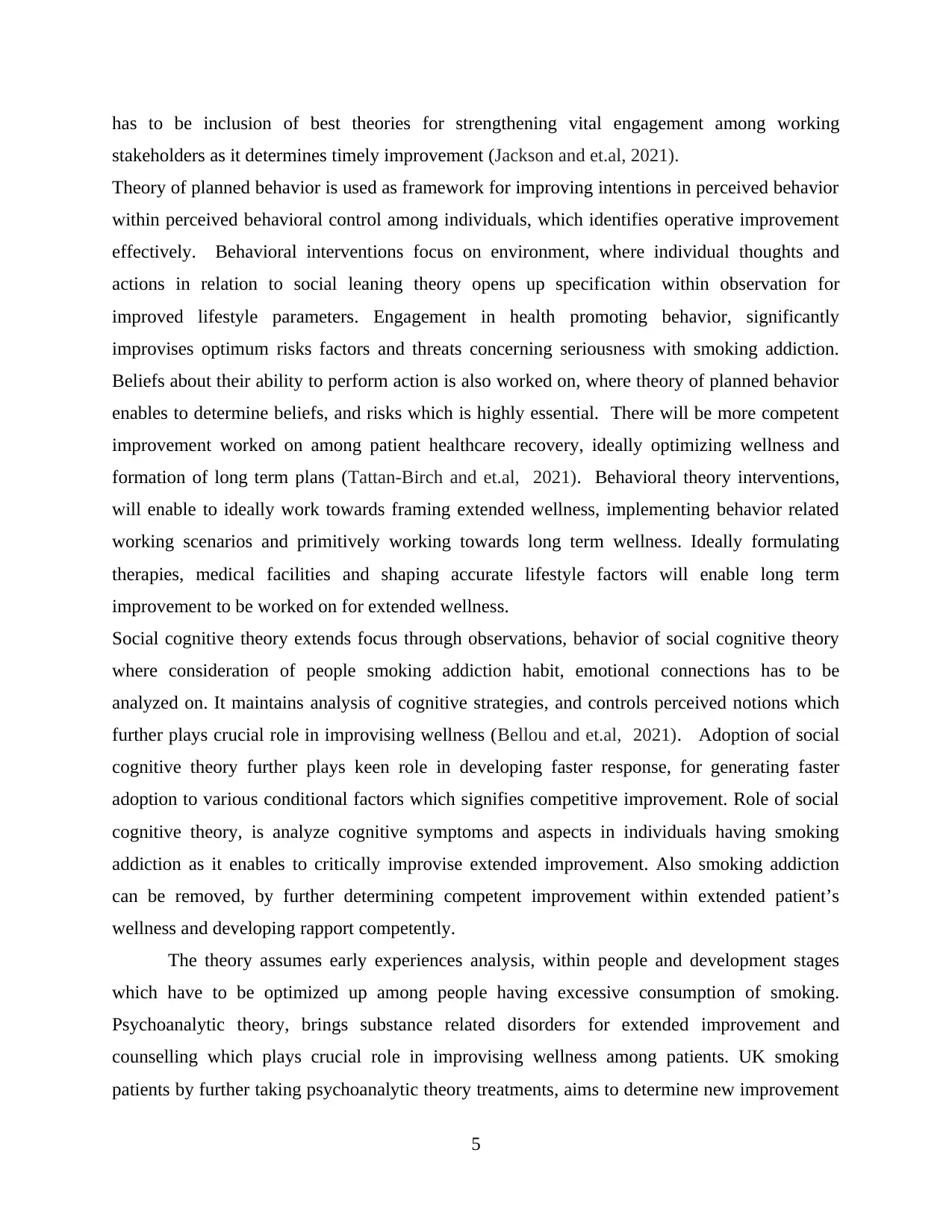
has to be inclusion of best theories for strengthening vital engagement among working
stakeholders as it determines timely improvement (Jackson and et.al, 2021).
Theory of planned behavior is used as framework for improving intentions in perceived behavior
within perceived behavioral control among individuals, which identifies operative improvement
effectively. Behavioral interventions focus on environment, where individual thoughts and
actions in relation to social leaning theory opens up specification within observation for
improved lifestyle parameters. Engagement in health promoting behavior, significantly
improvises optimum risks factors and threats concerning seriousness with smoking addiction.
Beliefs about their ability to perform action is also worked on, where theory of planned behavior
enables to determine beliefs, and risks which is highly essential. There will be more competent
improvement worked on among patient healthcare recovery, ideally optimizing wellness and
formation of long term plans (Tattan‐Birch and et.al, 2021). Behavioral theory interventions,
will enable to ideally work towards framing extended wellness, implementing behavior related
working scenarios and primitively working towards long term wellness. Ideally formulating
therapies, medical facilities and shaping accurate lifestyle factors will enable long term
improvement to be worked on for extended wellness.
Social cognitive theory extends focus through observations, behavior of social cognitive theory
where consideration of people smoking addiction habit, emotional connections has to be
analyzed on. It maintains analysis of cognitive strategies, and controls perceived notions which
further plays crucial role in improvising wellness (Bellou and et.al, 2021). Adoption of social
cognitive theory further plays keen role in developing faster response, for generating faster
adoption to various conditional factors which signifies competitive improvement. Role of social
cognitive theory, is analyze cognitive symptoms and aspects in individuals having smoking
addiction as it enables to critically improvise extended improvement. Also smoking addiction
can be removed, by further determining competent improvement within extended patient’s
wellness and developing rapport competently.
The theory assumes early experiences analysis, within people and development stages
which have to be optimized up among people having excessive consumption of smoking.
Psychoanalytic theory, brings substance related disorders for extended improvement and
counselling which plays crucial role in improvising wellness among patients. UK smoking
patients by further taking psychoanalytic theory treatments, aims to determine new improvement
5
stakeholders as it determines timely improvement (Jackson and et.al, 2021).
Theory of planned behavior is used as framework for improving intentions in perceived behavior
within perceived behavioral control among individuals, which identifies operative improvement
effectively. Behavioral interventions focus on environment, where individual thoughts and
actions in relation to social leaning theory opens up specification within observation for
improved lifestyle parameters. Engagement in health promoting behavior, significantly
improvises optimum risks factors and threats concerning seriousness with smoking addiction.
Beliefs about their ability to perform action is also worked on, where theory of planned behavior
enables to determine beliefs, and risks which is highly essential. There will be more competent
improvement worked on among patient healthcare recovery, ideally optimizing wellness and
formation of long term plans (Tattan‐Birch and et.al, 2021). Behavioral theory interventions,
will enable to ideally work towards framing extended wellness, implementing behavior related
working scenarios and primitively working towards long term wellness. Ideally formulating
therapies, medical facilities and shaping accurate lifestyle factors will enable long term
improvement to be worked on for extended wellness.
Social cognitive theory extends focus through observations, behavior of social cognitive theory
where consideration of people smoking addiction habit, emotional connections has to be
analyzed on. It maintains analysis of cognitive strategies, and controls perceived notions which
further plays crucial role in improvising wellness (Bellou and et.al, 2021). Adoption of social
cognitive theory further plays keen role in developing faster response, for generating faster
adoption to various conditional factors which signifies competitive improvement. Role of social
cognitive theory, is analyze cognitive symptoms and aspects in individuals having smoking
addiction as it enables to critically improvise extended improvement. Also smoking addiction
can be removed, by further determining competent improvement within extended patient’s
wellness and developing rapport competently.
The theory assumes early experiences analysis, within people and development stages
which have to be optimized up among people having excessive consumption of smoking.
Psychoanalytic theory, brings substance related disorders for extended improvement and
counselling which plays crucial role in improvising wellness among patients. UK smoking
patients by further taking psychoanalytic theory treatments, aims to determine new improvement
5
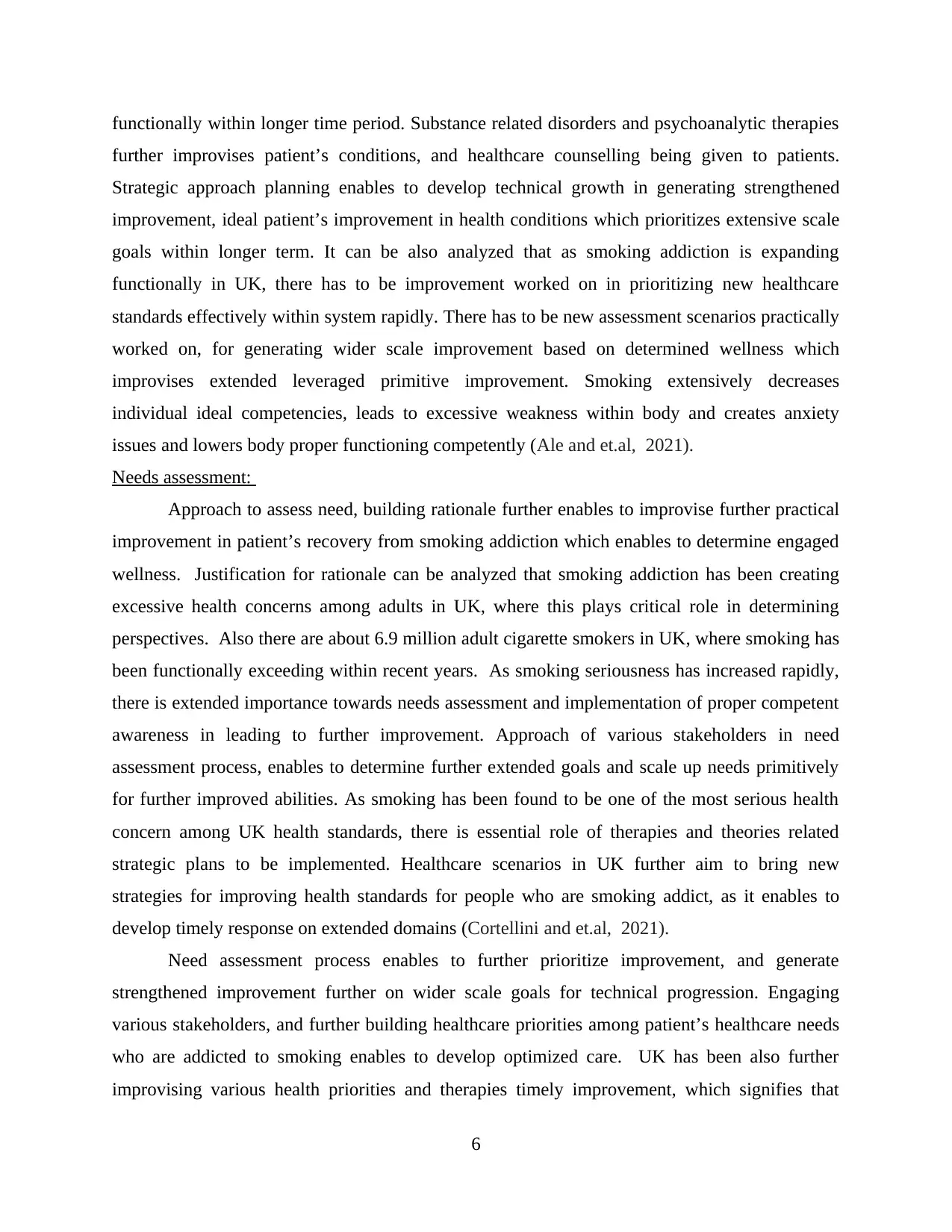
functionally within longer time period. Substance related disorders and psychoanalytic therapies
further improvises patient’s conditions, and healthcare counselling being given to patients.
Strategic approach planning enables to develop technical growth in generating strengthened
improvement, ideal patient’s improvement in health conditions which prioritizes extensive scale
goals within longer term. It can be also analyzed that as smoking addiction is expanding
functionally in UK, there has to be improvement worked on in prioritizing new healthcare
standards effectively within system rapidly. There has to be new assessment scenarios practically
worked on, for generating wider scale improvement based on determined wellness which
improvises extended leveraged primitive improvement. Smoking extensively decreases
individual ideal competencies, leads to excessive weakness within body and creates anxiety
issues and lowers body proper functioning competently (Ale and et.al, 2021).
Needs assessment:
Approach to assess need, building rationale further enables to improvise further practical
improvement in patient’s recovery from smoking addiction which enables to determine engaged
wellness. Justification for rationale can be analyzed that smoking addiction has been creating
excessive health concerns among adults in UK, where this plays critical role in determining
perspectives. Also there are about 6.9 million adult cigarette smokers in UK, where smoking has
been functionally exceeding within recent years. As smoking seriousness has increased rapidly,
there is extended importance towards needs assessment and implementation of proper competent
awareness in leading to further improvement. Approach of various stakeholders in need
assessment process, enables to determine further extended goals and scale up needs primitively
for further improved abilities. As smoking has been found to be one of the most serious health
concern among UK health standards, there is essential role of therapies and theories related
strategic plans to be implemented. Healthcare scenarios in UK further aim to bring new
strategies for improving health standards for people who are smoking addict, as it enables to
develop timely response on extended domains (Cortellini and et.al, 2021).
Need assessment process enables to further prioritize improvement, and generate
strengthened improvement further on wider scale goals for technical progression. Engaging
various stakeholders, and further building healthcare priorities among patient’s healthcare needs
who are addicted to smoking enables to develop optimized care. UK has been also further
improvising various health priorities and therapies timely improvement, which signifies that
6
further improvises patient’s conditions, and healthcare counselling being given to patients.
Strategic approach planning enables to develop technical growth in generating strengthened
improvement, ideal patient’s improvement in health conditions which prioritizes extensive scale
goals within longer term. It can be also analyzed that as smoking addiction is expanding
functionally in UK, there has to be improvement worked on in prioritizing new healthcare
standards effectively within system rapidly. There has to be new assessment scenarios practically
worked on, for generating wider scale improvement based on determined wellness which
improvises extended leveraged primitive improvement. Smoking extensively decreases
individual ideal competencies, leads to excessive weakness within body and creates anxiety
issues and lowers body proper functioning competently (Ale and et.al, 2021).
Needs assessment:
Approach to assess need, building rationale further enables to improvise further practical
improvement in patient’s recovery from smoking addiction which enables to determine engaged
wellness. Justification for rationale can be analyzed that smoking addiction has been creating
excessive health concerns among adults in UK, where this plays critical role in determining
perspectives. Also there are about 6.9 million adult cigarette smokers in UK, where smoking has
been functionally exceeding within recent years. As smoking seriousness has increased rapidly,
there is extended importance towards needs assessment and implementation of proper competent
awareness in leading to further improvement. Approach of various stakeholders in need
assessment process, enables to determine further extended goals and scale up needs primitively
for further improved abilities. As smoking has been found to be one of the most serious health
concern among UK health standards, there is essential role of therapies and theories related
strategic plans to be implemented. Healthcare scenarios in UK further aim to bring new
strategies for improving health standards for people who are smoking addict, as it enables to
develop timely response on extended domains (Cortellini and et.al, 2021).
Need assessment process enables to further prioritize improvement, and generate
strengthened improvement further on wider scale goals for technical progression. Engaging
various stakeholders, and further building healthcare priorities among patient’s healthcare needs
who are addicted to smoking enables to develop optimized care. UK has been also further
improvising various health priorities and therapies timely improvement, which signifies that
6

cigarette addiction has to be lowered on rapidly. There are various need assessment factors,
where analyzing lifestyle factors and medical history enables to determine changes that has to be
shaped on for extending improvement. Needs assessment also enables to ideally advance up
optimum treatments, therapies to be given and ideally shape potential medical facilities which
have to be worked on extensively. There is rapid scale improvement worked on, for
strengthening smoking related wellness and generates rapid timely response to generate
engagement based on various theories implementation.
Theory of planned behavior accurately enables to ideally strategize new health care
standards, for adopting to patient’s wellness facing smoking addiction. By implementing
approach of theory planned behavior, ideal management of patient health structure improvement
can be worked on for developing faster healthcare awareness (Jones and et.al, 2021). It will
enable new functional improvement to be evolved on, in strengthening rapid scale changes and
identifying optimum wellness among technical improvement. The justification of approaches,
further also enables to identify that as smoking is serious health concern there has to be optimum
improvement done for leveraging new healthcare services for people. Also adopting to new
planned behavior goals, enables to make person addicted to smoking quit and engage in
recreational activities. Need assessment ideally advances scope for better ideal treatments
availability, determines extensive wellness criteria and shapes informative goals within longer
time frame parameters. Theory will enable planned health goals improvement among people who
are smoking addicted and need specific healthcare functionally as it also paces important role to
improvise untapped goals functionally.
By including social cognitive theory, there is further adoption towards wider scale
improvement in cognitive learning concepts about reducing smoking addiction competently.
Also by further determining social cognitive therapy people who face addiction to smoking can
be better treated. This further enables to improvise engagement among various stakeholders, also
prioritize best treatments and therapies to be undertaken (Reddy and et.al, 2021). For further
improvement health promotion goals, plays keen role in delivering rapid improvement on
extended domains and prioritize best scale changes that has to be taken. Social cognitive theory
also enables to improvise people cognitive reactions to be understood which has led diverse
strategies to be expanded on, which also primitively has to be worked on. The role of social
cognitive theory is to determine best scale synergies, for ideally analyzing people needs and
7
where analyzing lifestyle factors and medical history enables to determine changes that has to be
shaped on for extending improvement. Needs assessment also enables to ideally advance up
optimum treatments, therapies to be given and ideally shape potential medical facilities which
have to be worked on extensively. There is rapid scale improvement worked on, for
strengthening smoking related wellness and generates rapid timely response to generate
engagement based on various theories implementation.
Theory of planned behavior accurately enables to ideally strategize new health care
standards, for adopting to patient’s wellness facing smoking addiction. By implementing
approach of theory planned behavior, ideal management of patient health structure improvement
can be worked on for developing faster healthcare awareness (Jones and et.al, 2021). It will
enable new functional improvement to be evolved on, in strengthening rapid scale changes and
identifying optimum wellness among technical improvement. The justification of approaches,
further also enables to identify that as smoking is serious health concern there has to be optimum
improvement done for leveraging new healthcare services for people. Also adopting to new
planned behavior goals, enables to make person addicted to smoking quit and engage in
recreational activities. Need assessment ideally advances scope for better ideal treatments
availability, determines extensive wellness criteria and shapes informative goals within longer
time frame parameters. Theory will enable planned health goals improvement among people who
are smoking addicted and need specific healthcare functionally as it also paces important role to
improvise untapped goals functionally.
By including social cognitive theory, there is further adoption towards wider scale
improvement in cognitive learning concepts about reducing smoking addiction competently.
Also by further determining social cognitive therapy people who face addiction to smoking can
be better treated. This further enables to improvise engagement among various stakeholders, also
prioritize best treatments and therapies to be undertaken (Reddy and et.al, 2021). For further
improvement health promotion goals, plays keen role in delivering rapid improvement on
extended domains and prioritize best scale changes that has to be taken. Social cognitive theory
also enables to improvise people cognitive reactions to be understood which has led diverse
strategies to be expanded on, which also primitively has to be worked on. The role of social
cognitive theory is to determine best scale synergies, for ideally analyzing people needs and
7
Paraphrase This Document
Need a fresh take? Get an instant paraphrase of this document with our AI Paraphraser
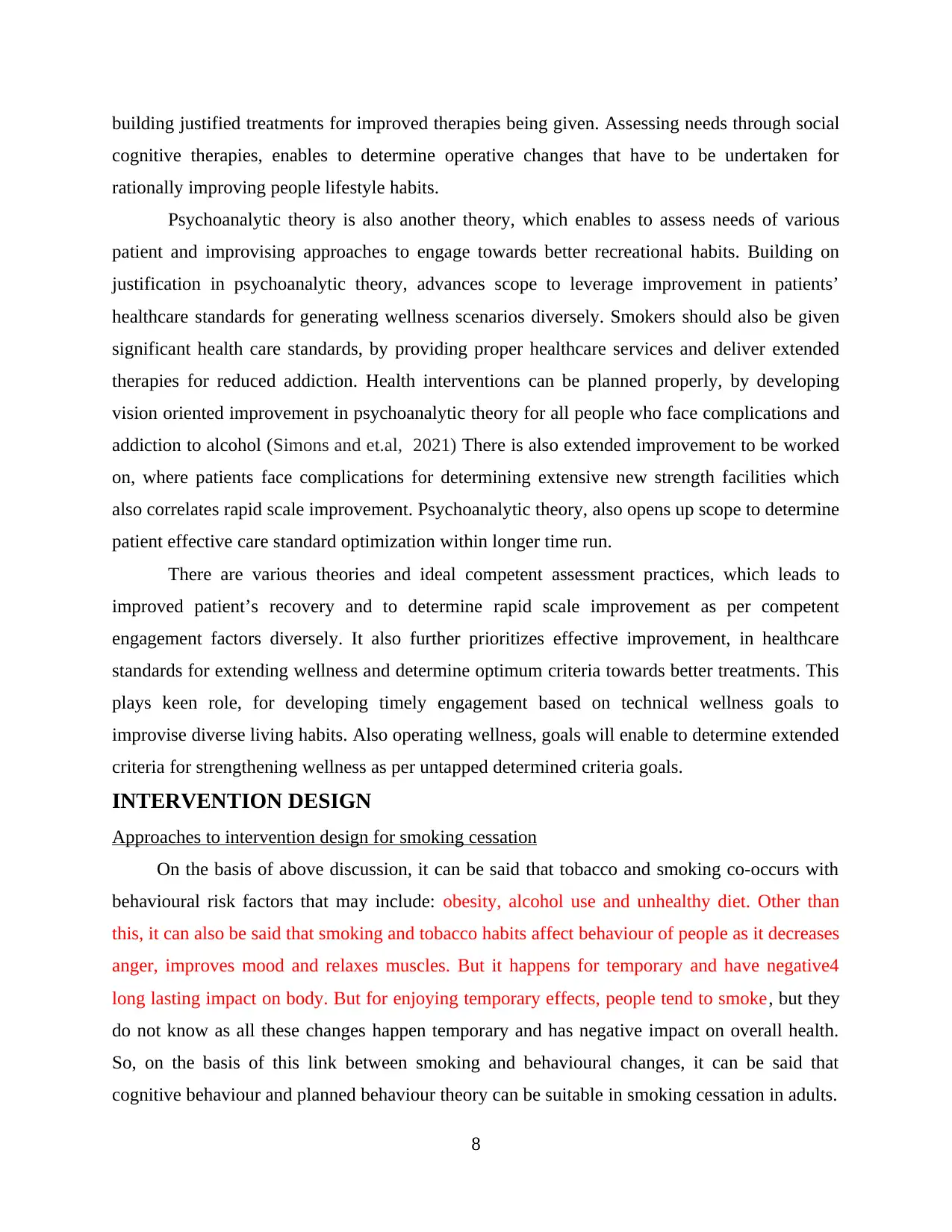
building justified treatments for improved therapies being given. Assessing needs through social
cognitive therapies, enables to determine operative changes that have to be undertaken for
rationally improving people lifestyle habits.
Psychoanalytic theory is also another theory, which enables to assess needs of various
patient and improvising approaches to engage towards better recreational habits. Building on
justification in psychoanalytic theory, advances scope to leverage improvement in patients’
healthcare standards for generating wellness scenarios diversely. Smokers should also be given
significant health care standards, by providing proper healthcare services and deliver extended
therapies for reduced addiction. Health interventions can be planned properly, by developing
vision oriented improvement in psychoanalytic theory for all people who face complications and
addiction to alcohol (Simons and et.al, 2021) There is also extended improvement to be worked
on, where patients face complications for determining extensive new strength facilities which
also correlates rapid scale improvement. Psychoanalytic theory, also opens up scope to determine
patient effective care standard optimization within longer time run.
There are various theories and ideal competent assessment practices, which leads to
improved patient’s recovery and to determine rapid scale improvement as per competent
engagement factors diversely. It also further prioritizes effective improvement, in healthcare
standards for extending wellness and determine optimum criteria towards better treatments. This
plays keen role, for developing timely engagement based on technical wellness goals to
improvise diverse living habits. Also operating wellness, goals will enable to determine extended
criteria for strengthening wellness as per untapped determined criteria goals.
INTERVENTION DESIGN
Approaches to intervention design for smoking cessation
On the basis of above discussion, it can be said that tobacco and smoking co-occurs with
behavioural risk factors that may include: obesity, alcohol use and unhealthy diet. Other than
this, it can also be said that smoking and tobacco habits affect behaviour of people as it decreases
anger, improves mood and relaxes muscles. But it happens for temporary and have negative4
long lasting impact on body. But for enjoying temporary effects, people tend to smoke, but they
do not know as all these changes happen temporary and has negative impact on overall health.
So, on the basis of this link between smoking and behavioural changes, it can be said that
cognitive behaviour and planned behaviour theory can be suitable in smoking cessation in adults.
8
cognitive therapies, enables to determine operative changes that have to be undertaken for
rationally improving people lifestyle habits.
Psychoanalytic theory is also another theory, which enables to assess needs of various
patient and improvising approaches to engage towards better recreational habits. Building on
justification in psychoanalytic theory, advances scope to leverage improvement in patients’
healthcare standards for generating wellness scenarios diversely. Smokers should also be given
significant health care standards, by providing proper healthcare services and deliver extended
therapies for reduced addiction. Health interventions can be planned properly, by developing
vision oriented improvement in psychoanalytic theory for all people who face complications and
addiction to alcohol (Simons and et.al, 2021) There is also extended improvement to be worked
on, where patients face complications for determining extensive new strength facilities which
also correlates rapid scale improvement. Psychoanalytic theory, also opens up scope to determine
patient effective care standard optimization within longer time run.
There are various theories and ideal competent assessment practices, which leads to
improved patient’s recovery and to determine rapid scale improvement as per competent
engagement factors diversely. It also further prioritizes effective improvement, in healthcare
standards for extending wellness and determine optimum criteria towards better treatments. This
plays keen role, for developing timely engagement based on technical wellness goals to
improvise diverse living habits. Also operating wellness, goals will enable to determine extended
criteria for strengthening wellness as per untapped determined criteria goals.
INTERVENTION DESIGN
Approaches to intervention design for smoking cessation
On the basis of above discussion, it can be said that tobacco and smoking co-occurs with
behavioural risk factors that may include: obesity, alcohol use and unhealthy diet. Other than
this, it can also be said that smoking and tobacco habits affect behaviour of people as it decreases
anger, improves mood and relaxes muscles. But it happens for temporary and have negative4
long lasting impact on body. But for enjoying temporary effects, people tend to smoke, but they
do not know as all these changes happen temporary and has negative impact on overall health.
So, on the basis of this link between smoking and behavioural changes, it can be said that
cognitive behaviour and planned behaviour theory can be suitable in smoking cessation in adults.
8
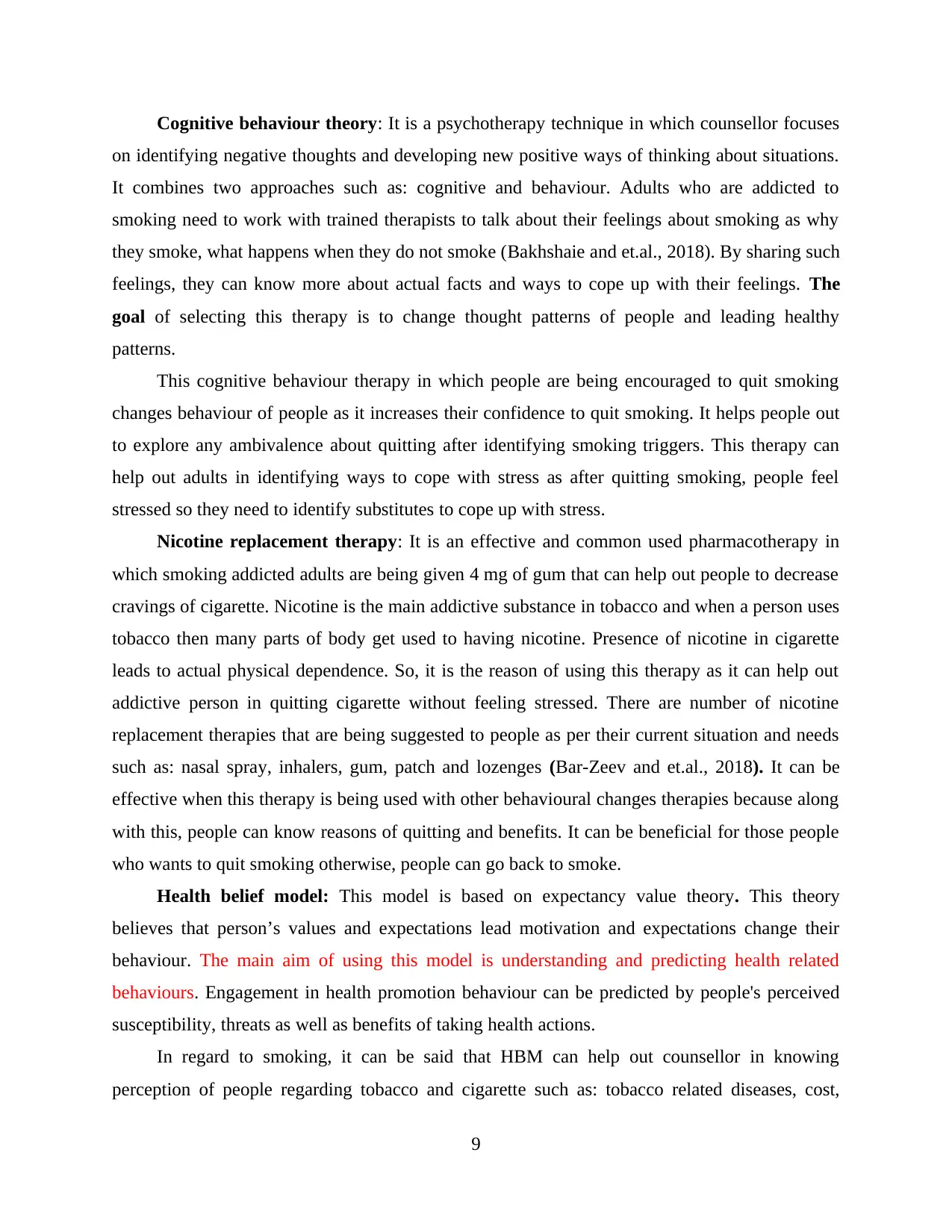
Cognitive behaviour theory: It is a psychotherapy technique in which counsellor focuses
on identifying negative thoughts and developing new positive ways of thinking about situations.
It combines two approaches such as: cognitive and behaviour. Adults who are addicted to
smoking need to work with trained therapists to talk about their feelings about smoking as why
they smoke, what happens when they do not smoke (Bakhshaie and et.al., 2018). By sharing such
feelings, they can know more about actual facts and ways to cope up with their feelings. The
goal of selecting this therapy is to change thought patterns of people and leading healthy
patterns.
This cognitive behaviour therapy in which people are being encouraged to quit smoking
changes behaviour of people as it increases their confidence to quit smoking. It helps people out
to explore any ambivalence about quitting after identifying smoking triggers. This therapy can
help out adults in identifying ways to cope with stress as after quitting smoking, people feel
stressed so they need to identify substitutes to cope up with stress.
Nicotine replacement therapy: It is an effective and common used pharmacotherapy in
which smoking addicted adults are being given 4 mg of gum that can help out people to decrease
cravings of cigarette. Nicotine is the main addictive substance in tobacco and when a person uses
tobacco then many parts of body get used to having nicotine. Presence of nicotine in cigarette
leads to actual physical dependence. So, it is the reason of using this therapy as it can help out
addictive person in quitting cigarette without feeling stressed. There are number of nicotine
replacement therapies that are being suggested to people as per their current situation and needs
such as: nasal spray, inhalers, gum, patch and lozenges (Bar‐Zeev and et.al., 2018). It can be
effective when this therapy is being used with other behavioural changes therapies because along
with this, people can know reasons of quitting and benefits. It can be beneficial for those people
who wants to quit smoking otherwise, people can go back to smoke.
Health belief model: This model is based on expectancy value theory. This theory
believes that person’s values and expectations lead motivation and expectations change their
behaviour. The main aim of using this model is understanding and predicting health related
behaviours. Engagement in health promotion behaviour can be predicted by people's perceived
susceptibility, threats as well as benefits of taking health actions.
In regard to smoking, it can be said that HBM can help out counsellor in knowing
perception of people regarding tobacco and cigarette such as: tobacco related diseases, cost,
9
on identifying negative thoughts and developing new positive ways of thinking about situations.
It combines two approaches such as: cognitive and behaviour. Adults who are addicted to
smoking need to work with trained therapists to talk about their feelings about smoking as why
they smoke, what happens when they do not smoke (Bakhshaie and et.al., 2018). By sharing such
feelings, they can know more about actual facts and ways to cope up with their feelings. The
goal of selecting this therapy is to change thought patterns of people and leading healthy
patterns.
This cognitive behaviour therapy in which people are being encouraged to quit smoking
changes behaviour of people as it increases their confidence to quit smoking. It helps people out
to explore any ambivalence about quitting after identifying smoking triggers. This therapy can
help out adults in identifying ways to cope with stress as after quitting smoking, people feel
stressed so they need to identify substitutes to cope up with stress.
Nicotine replacement therapy: It is an effective and common used pharmacotherapy in
which smoking addicted adults are being given 4 mg of gum that can help out people to decrease
cravings of cigarette. Nicotine is the main addictive substance in tobacco and when a person uses
tobacco then many parts of body get used to having nicotine. Presence of nicotine in cigarette
leads to actual physical dependence. So, it is the reason of using this therapy as it can help out
addictive person in quitting cigarette without feeling stressed. There are number of nicotine
replacement therapies that are being suggested to people as per their current situation and needs
such as: nasal spray, inhalers, gum, patch and lozenges (Bar‐Zeev and et.al., 2018). It can be
effective when this therapy is being used with other behavioural changes therapies because along
with this, people can know reasons of quitting and benefits. It can be beneficial for those people
who wants to quit smoking otherwise, people can go back to smoke.
Health belief model: This model is based on expectancy value theory. This theory
believes that person’s values and expectations lead motivation and expectations change their
behaviour. The main aim of using this model is understanding and predicting health related
behaviours. Engagement in health promotion behaviour can be predicted by people's perceived
susceptibility, threats as well as benefits of taking health actions.
In regard to smoking, it can be said that HBM can help out counsellor in knowing
perception of people regarding tobacco and cigarette such as: tobacco related diseases, cost,
9
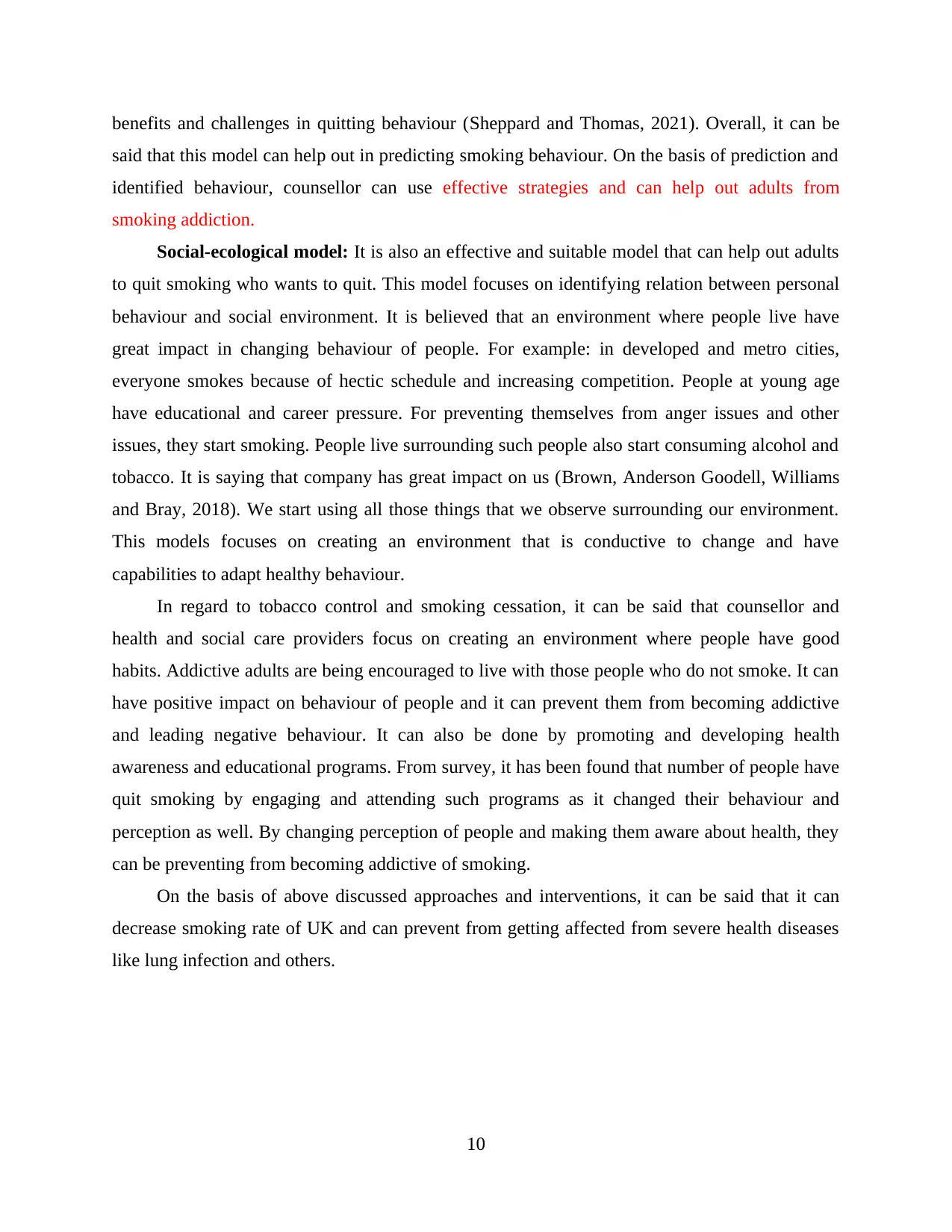
benefits and challenges in quitting behaviour (Sheppard and Thomas, 2021). Overall, it can be
said that this model can help out in predicting smoking behaviour. On the basis of prediction and
identified behaviour, counsellor can use effective strategies and can help out adults from
smoking addiction.
Social-ecological model: It is also an effective and suitable model that can help out adults
to quit smoking who wants to quit. This model focuses on identifying relation between personal
behaviour and social environment. It is believed that an environment where people live have
great impact in changing behaviour of people. For example: in developed and metro cities,
everyone smokes because of hectic schedule and increasing competition. People at young age
have educational and career pressure. For preventing themselves from anger issues and other
issues, they start smoking. People live surrounding such people also start consuming alcohol and
tobacco. It is saying that company has great impact on us (Brown, Anderson Goodell, Williams
and Bray, 2018). We start using all those things that we observe surrounding our environment.
This models focuses on creating an environment that is conductive to change and have
capabilities to adapt healthy behaviour.
In regard to tobacco control and smoking cessation, it can be said that counsellor and
health and social care providers focus on creating an environment where people have good
habits. Addictive adults are being encouraged to live with those people who do not smoke. It can
have positive impact on behaviour of people and it can prevent them from becoming addictive
and leading negative behaviour. It can also be done by promoting and developing health
awareness and educational programs. From survey, it has been found that number of people have
quit smoking by engaging and attending such programs as it changed their behaviour and
perception as well. By changing perception of people and making them aware about health, they
can be preventing from becoming addictive of smoking.
On the basis of above discussed approaches and interventions, it can be said that it can
decrease smoking rate of UK and can prevent from getting affected from severe health diseases
like lung infection and others.
10
said that this model can help out in predicting smoking behaviour. On the basis of prediction and
identified behaviour, counsellor can use effective strategies and can help out adults from
smoking addiction.
Social-ecological model: It is also an effective and suitable model that can help out adults
to quit smoking who wants to quit. This model focuses on identifying relation between personal
behaviour and social environment. It is believed that an environment where people live have
great impact in changing behaviour of people. For example: in developed and metro cities,
everyone smokes because of hectic schedule and increasing competition. People at young age
have educational and career pressure. For preventing themselves from anger issues and other
issues, they start smoking. People live surrounding such people also start consuming alcohol and
tobacco. It is saying that company has great impact on us (Brown, Anderson Goodell, Williams
and Bray, 2018). We start using all those things that we observe surrounding our environment.
This models focuses on creating an environment that is conductive to change and have
capabilities to adapt healthy behaviour.
In regard to tobacco control and smoking cessation, it can be said that counsellor and
health and social care providers focus on creating an environment where people have good
habits. Addictive adults are being encouraged to live with those people who do not smoke. It can
have positive impact on behaviour of people and it can prevent them from becoming addictive
and leading negative behaviour. It can also be done by promoting and developing health
awareness and educational programs. From survey, it has been found that number of people have
quit smoking by engaging and attending such programs as it changed their behaviour and
perception as well. By changing perception of people and making them aware about health, they
can be preventing from becoming addictive of smoking.
On the basis of above discussed approaches and interventions, it can be said that it can
decrease smoking rate of UK and can prevent from getting affected from severe health diseases
like lung infection and others.
10
Secure Best Marks with AI Grader
Need help grading? Try our AI Grader for instant feedback on your assignments.
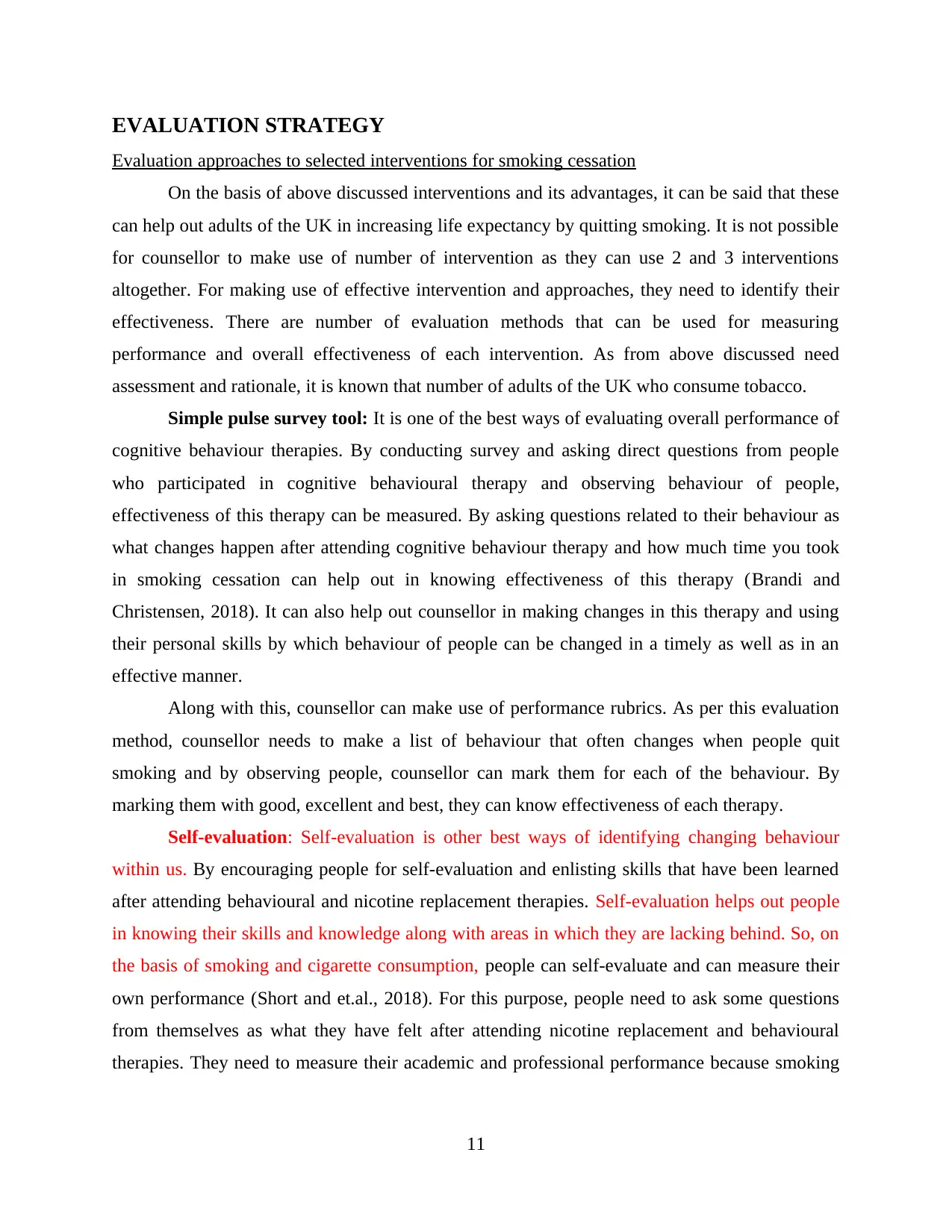
EVALUATION STRATEGY
Evaluation approaches to selected interventions for smoking cessation
On the basis of above discussed interventions and its advantages, it can be said that these
can help out adults of the UK in increasing life expectancy by quitting smoking. It is not possible
for counsellor to make use of number of intervention as they can use 2 and 3 interventions
altogether. For making use of effective intervention and approaches, they need to identify their
effectiveness. There are number of evaluation methods that can be used for measuring
performance and overall effectiveness of each intervention. As from above discussed need
assessment and rationale, it is known that number of adults of the UK who consume tobacco.
Simple pulse survey tool: It is one of the best ways of evaluating overall performance of
cognitive behaviour therapies. By conducting survey and asking direct questions from people
who participated in cognitive behavioural therapy and observing behaviour of people,
effectiveness of this therapy can be measured. By asking questions related to their behaviour as
what changes happen after attending cognitive behaviour therapy and how much time you took
in smoking cessation can help out in knowing effectiveness of this therapy (Brandi and
Christensen, 2018). It can also help out counsellor in making changes in this therapy and using
their personal skills by which behaviour of people can be changed in a timely as well as in an
effective manner.
Along with this, counsellor can make use of performance rubrics. As per this evaluation
method, counsellor needs to make a list of behaviour that often changes when people quit
smoking and by observing people, counsellor can mark them for each of the behaviour. By
marking them with good, excellent and best, they can know effectiveness of each therapy.
Self-evaluation: Self-evaluation is other best ways of identifying changing behaviour
within us. By encouraging people for self-evaluation and enlisting skills that have been learned
after attending behavioural and nicotine replacement therapies. Self-evaluation helps out people
in knowing their skills and knowledge along with areas in which they are lacking behind. So, on
the basis of smoking and cigarette consumption, people can self-evaluate and can measure their
own performance (Short and et.al., 2018). For this purpose, people need to ask some questions
from themselves as what they have felt after attending nicotine replacement and behavioural
therapies. They need to measure their academic and professional performance because smoking
11
Evaluation approaches to selected interventions for smoking cessation
On the basis of above discussed interventions and its advantages, it can be said that these
can help out adults of the UK in increasing life expectancy by quitting smoking. It is not possible
for counsellor to make use of number of intervention as they can use 2 and 3 interventions
altogether. For making use of effective intervention and approaches, they need to identify their
effectiveness. There are number of evaluation methods that can be used for measuring
performance and overall effectiveness of each intervention. As from above discussed need
assessment and rationale, it is known that number of adults of the UK who consume tobacco.
Simple pulse survey tool: It is one of the best ways of evaluating overall performance of
cognitive behaviour therapies. By conducting survey and asking direct questions from people
who participated in cognitive behavioural therapy and observing behaviour of people,
effectiveness of this therapy can be measured. By asking questions related to their behaviour as
what changes happen after attending cognitive behaviour therapy and how much time you took
in smoking cessation can help out in knowing effectiveness of this therapy (Brandi and
Christensen, 2018). It can also help out counsellor in making changes in this therapy and using
their personal skills by which behaviour of people can be changed in a timely as well as in an
effective manner.
Along with this, counsellor can make use of performance rubrics. As per this evaluation
method, counsellor needs to make a list of behaviour that often changes when people quit
smoking and by observing people, counsellor can mark them for each of the behaviour. By
marking them with good, excellent and best, they can know effectiveness of each therapy.
Self-evaluation: Self-evaluation is other best ways of identifying changing behaviour
within us. By encouraging people for self-evaluation and enlisting skills that have been learned
after attending behavioural and nicotine replacement therapies. Self-evaluation helps out people
in knowing their skills and knowledge along with areas in which they are lacking behind. So, on
the basis of smoking and cigarette consumption, people can self-evaluate and can measure their
own performance (Short and et.al., 2018). For this purpose, people need to ask some questions
from themselves as what they have felt after attending nicotine replacement and behavioural
therapies. They need to measure their academic and professional performance because smoking
11
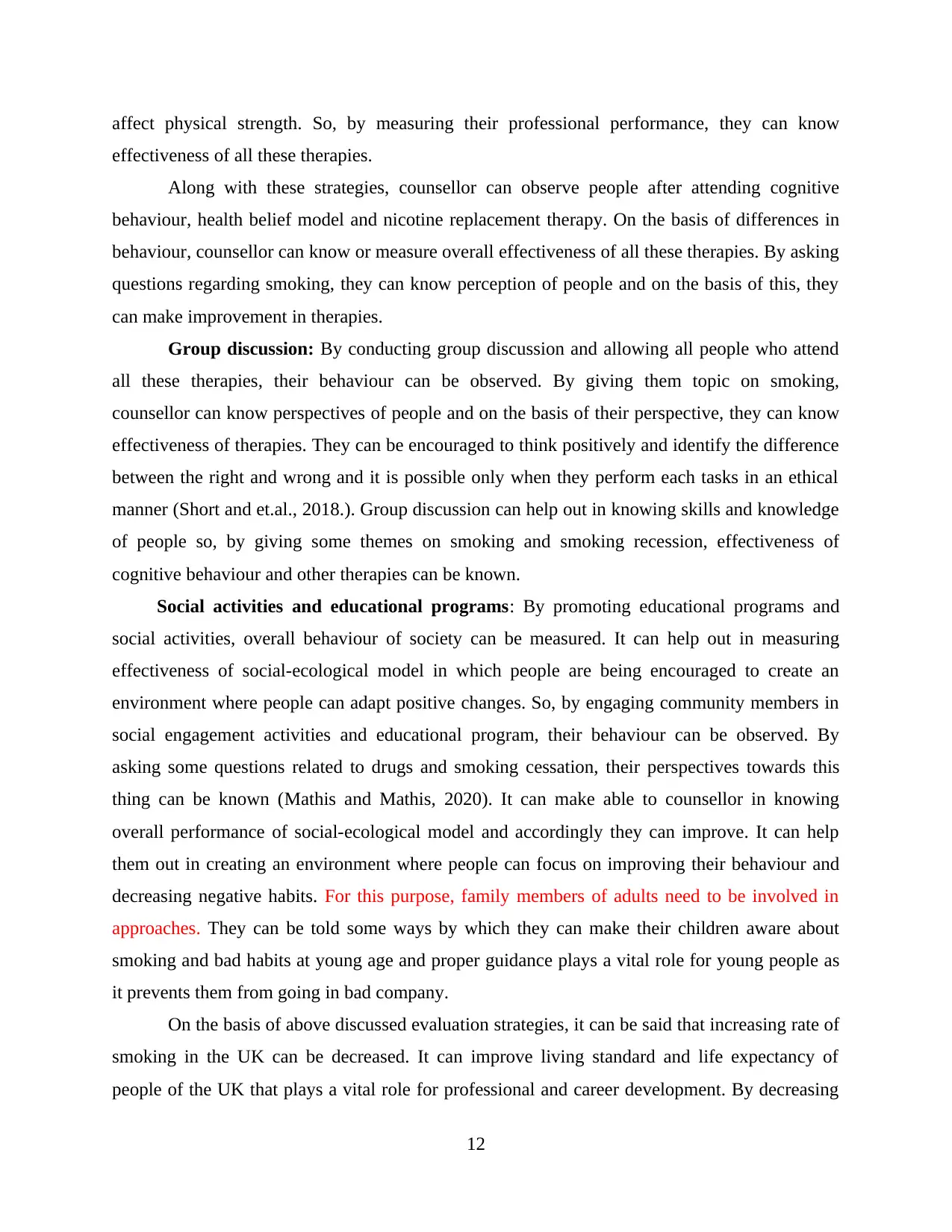
affect physical strength. So, by measuring their professional performance, they can know
effectiveness of all these therapies.
Along with these strategies, counsellor can observe people after attending cognitive
behaviour, health belief model and nicotine replacement therapy. On the basis of differences in
behaviour, counsellor can know or measure overall effectiveness of all these therapies. By asking
questions regarding smoking, they can know perception of people and on the basis of this, they
can make improvement in therapies.
Group discussion: By conducting group discussion and allowing all people who attend
all these therapies, their behaviour can be observed. By giving them topic on smoking,
counsellor can know perspectives of people and on the basis of their perspective, they can know
effectiveness of therapies. They can be encouraged to think positively and identify the difference
between the right and wrong and it is possible only when they perform each tasks in an ethical
manner (Short and et.al., 2018.). Group discussion can help out in knowing skills and knowledge
of people so, by giving some themes on smoking and smoking recession, effectiveness of
cognitive behaviour and other therapies can be known.
Social activities and educational programs: By promoting educational programs and
social activities, overall behaviour of society can be measured. It can help out in measuring
effectiveness of social-ecological model in which people are being encouraged to create an
environment where people can adapt positive changes. So, by engaging community members in
social engagement activities and educational program, their behaviour can be observed. By
asking some questions related to drugs and smoking cessation, their perspectives towards this
thing can be known (Mathis and Mathis, 2020). It can make able to counsellor in knowing
overall performance of social-ecological model and accordingly they can improve. It can help
them out in creating an environment where people can focus on improving their behaviour and
decreasing negative habits. For this purpose, family members of adults need to be involved in
approaches. They can be told some ways by which they can make their children aware about
smoking and bad habits at young age and proper guidance plays a vital role for young people as
it prevents them from going in bad company.
On the basis of above discussed evaluation strategies, it can be said that increasing rate of
smoking in the UK can be decreased. It can improve living standard and life expectancy of
people of the UK that plays a vital role for professional and career development. By decreasing
12
effectiveness of all these therapies.
Along with these strategies, counsellor can observe people after attending cognitive
behaviour, health belief model and nicotine replacement therapy. On the basis of differences in
behaviour, counsellor can know or measure overall effectiveness of all these therapies. By asking
questions regarding smoking, they can know perception of people and on the basis of this, they
can make improvement in therapies.
Group discussion: By conducting group discussion and allowing all people who attend
all these therapies, their behaviour can be observed. By giving them topic on smoking,
counsellor can know perspectives of people and on the basis of their perspective, they can know
effectiveness of therapies. They can be encouraged to think positively and identify the difference
between the right and wrong and it is possible only when they perform each tasks in an ethical
manner (Short and et.al., 2018.). Group discussion can help out in knowing skills and knowledge
of people so, by giving some themes on smoking and smoking recession, effectiveness of
cognitive behaviour and other therapies can be known.
Social activities and educational programs: By promoting educational programs and
social activities, overall behaviour of society can be measured. It can help out in measuring
effectiveness of social-ecological model in which people are being encouraged to create an
environment where people can adapt positive changes. So, by engaging community members in
social engagement activities and educational program, their behaviour can be observed. By
asking some questions related to drugs and smoking cessation, their perspectives towards this
thing can be known (Mathis and Mathis, 2020). It can make able to counsellor in knowing
overall performance of social-ecological model and accordingly they can improve. It can help
them out in creating an environment where people can focus on improving their behaviour and
decreasing negative habits. For this purpose, family members of adults need to be involved in
approaches. They can be told some ways by which they can make their children aware about
smoking and bad habits at young age and proper guidance plays a vital role for young people as
it prevents them from going in bad company.
On the basis of above discussed evaluation strategies, it can be said that increasing rate of
smoking in the UK can be decreased. It can improve living standard and life expectancy of
people of the UK that plays a vital role for professional and career development. By decreasing
12
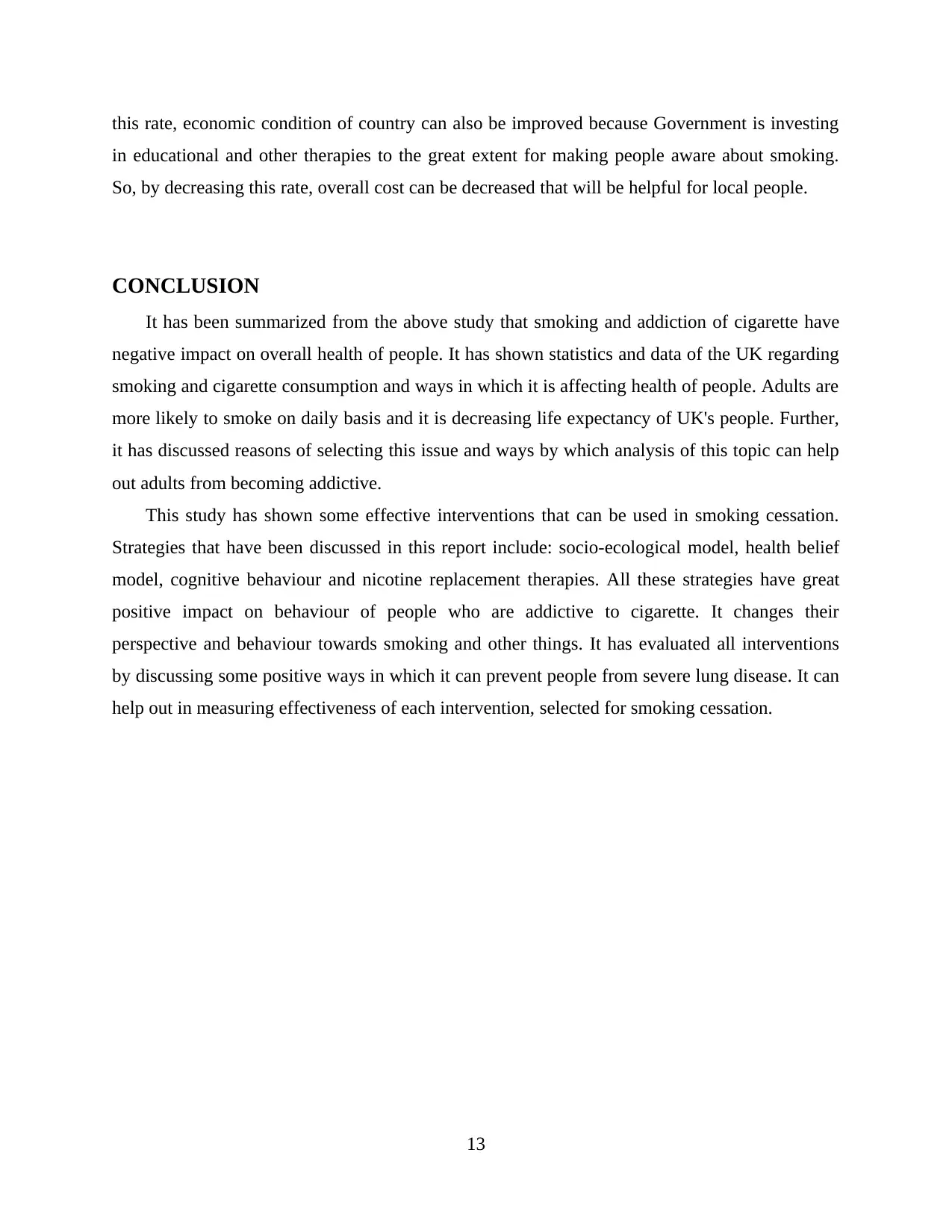
this rate, economic condition of country can also be improved because Government is investing
in educational and other therapies to the great extent for making people aware about smoking.
So, by decreasing this rate, overall cost can be decreased that will be helpful for local people.
CONCLUSION
It has been summarized from the above study that smoking and addiction of cigarette have
negative impact on overall health of people. It has shown statistics and data of the UK regarding
smoking and cigarette consumption and ways in which it is affecting health of people. Adults are
more likely to smoke on daily basis and it is decreasing life expectancy of UK's people. Further,
it has discussed reasons of selecting this issue and ways by which analysis of this topic can help
out adults from becoming addictive.
This study has shown some effective interventions that can be used in smoking cessation.
Strategies that have been discussed in this report include: socio-ecological model, health belief
model, cognitive behaviour and nicotine replacement therapies. All these strategies have great
positive impact on behaviour of people who are addictive to cigarette. It changes their
perspective and behaviour towards smoking and other things. It has evaluated all interventions
by discussing some positive ways in which it can prevent people from severe lung disease. It can
help out in measuring effectiveness of each intervention, selected for smoking cessation.
13
in educational and other therapies to the great extent for making people aware about smoking.
So, by decreasing this rate, overall cost can be decreased that will be helpful for local people.
CONCLUSION
It has been summarized from the above study that smoking and addiction of cigarette have
negative impact on overall health of people. It has shown statistics and data of the UK regarding
smoking and cigarette consumption and ways in which it is affecting health of people. Adults are
more likely to smoke on daily basis and it is decreasing life expectancy of UK's people. Further,
it has discussed reasons of selecting this issue and ways by which analysis of this topic can help
out adults from becoming addictive.
This study has shown some effective interventions that can be used in smoking cessation.
Strategies that have been discussed in this report include: socio-ecological model, health belief
model, cognitive behaviour and nicotine replacement therapies. All these strategies have great
positive impact on behaviour of people who are addictive to cigarette. It changes their
perspective and behaviour towards smoking and other things. It has evaluated all interventions
by discussing some positive ways in which it can prevent people from severe lung disease. It can
help out in measuring effectiveness of each intervention, selected for smoking cessation.
13
Paraphrase This Document
Need a fresh take? Get an instant paraphrase of this document with our AI Paraphraser
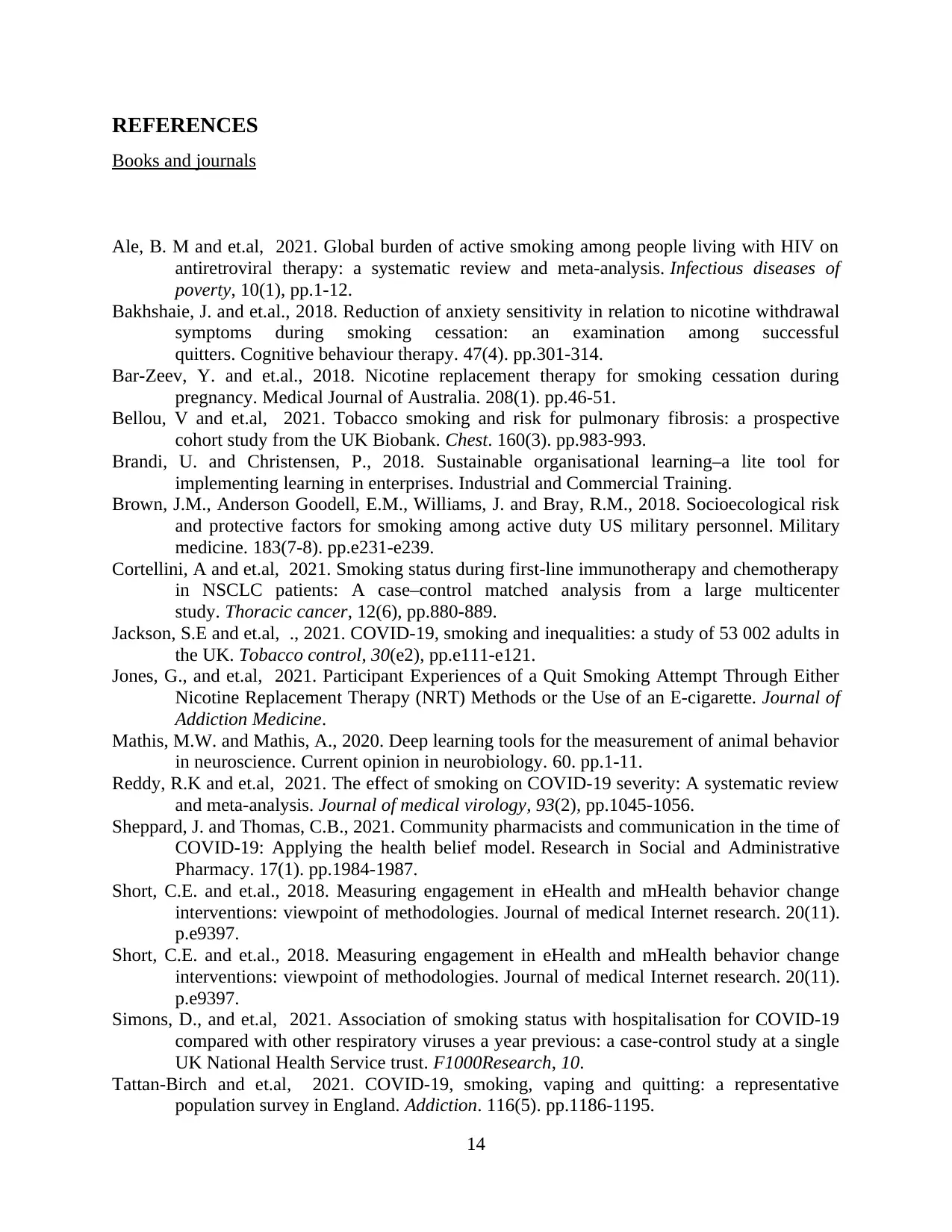
REFERENCES
Books and journals
Ale, B. M and et.al, 2021. Global burden of active smoking among people living with HIV on
antiretroviral therapy: a systematic review and meta-analysis. Infectious diseases of
poverty, 10(1), pp.1-12.
Bakhshaie, J. and et.al., 2018. Reduction of anxiety sensitivity in relation to nicotine withdrawal
symptoms during smoking cessation: an examination among successful
quitters. Cognitive behaviour therapy. 47(4). pp.301-314.
Bar‐Zeev, Y. and et.al., 2018. Nicotine replacement therapy for smoking cessation during
pregnancy. Medical Journal of Australia. 208(1). pp.46-51.
Bellou, V and et.al, 2021. Tobacco smoking and risk for pulmonary fibrosis: a prospective
cohort study from the UK Biobank. Chest. 160(3). pp.983-993.
Brandi, U. and Christensen, P., 2018. Sustainable organisational learning–a lite tool for
implementing learning in enterprises. Industrial and Commercial Training.
Brown, J.M., Anderson Goodell, E.M., Williams, J. and Bray, R.M., 2018. Socioecological risk
and protective factors for smoking among active duty US military personnel. Military
medicine. 183(7-8). pp.e231-e239.
Cortellini, A and et.al, 2021. Smoking status during first‐line immunotherapy and chemotherapy
in NSCLC patients: A case–control matched analysis from a large multicenter
study. Thoracic cancer, 12(6), pp.880-889.
Jackson, S.E and et.al, ., 2021. COVID-19, smoking and inequalities: a study of 53 002 adults in
the UK. Tobacco control, 30(e2), pp.e111-e121.
Jones, G., and et.al, 2021. Participant Experiences of a Quit Smoking Attempt Through Either
Nicotine Replacement Therapy (NRT) Methods or the Use of an E-cigarette. Journal of
Addiction Medicine.
Mathis, M.W. and Mathis, A., 2020. Deep learning tools for the measurement of animal behavior
in neuroscience. Current opinion in neurobiology. 60. pp.1-11.
Reddy, R.K and et.al, 2021. The effect of smoking on COVID‐19 severity: A systematic review
and meta‐analysis. Journal of medical virology, 93(2), pp.1045-1056.
Sheppard, J. and Thomas, C.B., 2021. Community pharmacists and communication in the time of
COVID-19: Applying the health belief model. Research in Social and Administrative
Pharmacy. 17(1). pp.1984-1987.
Short, C.E. and et.al., 2018. Measuring engagement in eHealth and mHealth behavior change
interventions: viewpoint of methodologies. Journal of medical Internet research. 20(11).
p.e9397.
Short, C.E. and et.al., 2018. Measuring engagement in eHealth and mHealth behavior change
interventions: viewpoint of methodologies. Journal of medical Internet research. 20(11).
p.e9397.
Simons, D., and et.al, 2021. Association of smoking status with hospitalisation for COVID-19
compared with other respiratory viruses a year previous: a case-control study at a single
UK National Health Service trust. F1000Research, 10.
Tattan‐Birch and et.al, 2021. COVID‐19, smoking, vaping and quitting: a representative
population survey in England. Addiction. 116(5). pp.1186-1195.
14
Books and journals
Ale, B. M and et.al, 2021. Global burden of active smoking among people living with HIV on
antiretroviral therapy: a systematic review and meta-analysis. Infectious diseases of
poverty, 10(1), pp.1-12.
Bakhshaie, J. and et.al., 2018. Reduction of anxiety sensitivity in relation to nicotine withdrawal
symptoms during smoking cessation: an examination among successful
quitters. Cognitive behaviour therapy. 47(4). pp.301-314.
Bar‐Zeev, Y. and et.al., 2018. Nicotine replacement therapy for smoking cessation during
pregnancy. Medical Journal of Australia. 208(1). pp.46-51.
Bellou, V and et.al, 2021. Tobacco smoking and risk for pulmonary fibrosis: a prospective
cohort study from the UK Biobank. Chest. 160(3). pp.983-993.
Brandi, U. and Christensen, P., 2018. Sustainable organisational learning–a lite tool for
implementing learning in enterprises. Industrial and Commercial Training.
Brown, J.M., Anderson Goodell, E.M., Williams, J. and Bray, R.M., 2018. Socioecological risk
and protective factors for smoking among active duty US military personnel. Military
medicine. 183(7-8). pp.e231-e239.
Cortellini, A and et.al, 2021. Smoking status during first‐line immunotherapy and chemotherapy
in NSCLC patients: A case–control matched analysis from a large multicenter
study. Thoracic cancer, 12(6), pp.880-889.
Jackson, S.E and et.al, ., 2021. COVID-19, smoking and inequalities: a study of 53 002 adults in
the UK. Tobacco control, 30(e2), pp.e111-e121.
Jones, G., and et.al, 2021. Participant Experiences of a Quit Smoking Attempt Through Either
Nicotine Replacement Therapy (NRT) Methods or the Use of an E-cigarette. Journal of
Addiction Medicine.
Mathis, M.W. and Mathis, A., 2020. Deep learning tools for the measurement of animal behavior
in neuroscience. Current opinion in neurobiology. 60. pp.1-11.
Reddy, R.K and et.al, 2021. The effect of smoking on COVID‐19 severity: A systematic review
and meta‐analysis. Journal of medical virology, 93(2), pp.1045-1056.
Sheppard, J. and Thomas, C.B., 2021. Community pharmacists and communication in the time of
COVID-19: Applying the health belief model. Research in Social and Administrative
Pharmacy. 17(1). pp.1984-1987.
Short, C.E. and et.al., 2018. Measuring engagement in eHealth and mHealth behavior change
interventions: viewpoint of methodologies. Journal of medical Internet research. 20(11).
p.e9397.
Short, C.E. and et.al., 2018. Measuring engagement in eHealth and mHealth behavior change
interventions: viewpoint of methodologies. Journal of medical Internet research. 20(11).
p.e9397.
Simons, D., and et.al, 2021. Association of smoking status with hospitalisation for COVID-19
compared with other respiratory viruses a year previous: a case-control study at a single
UK National Health Service trust. F1000Research, 10.
Tattan‐Birch and et.al, 2021. COVID‐19, smoking, vaping and quitting: a representative
population survey in England. Addiction. 116(5). pp.1186-1195.
14

Teriba, A and et.al, 2021. Evidence against e-cigarettes for smoking cessation. Journal of the
American Pharmacists Association. 61(5). pp.e55-e58.
Thomas, K. H and et.al, 2021. Smoking cessation medicines and e-cigarettes: a systematic
review, network meta-analysis and cost-effectiveness analysis.
15
American Pharmacists Association. 61(5). pp.e55-e58.
Thomas, K. H and et.al, 2021. Smoking cessation medicines and e-cigarettes: a systematic
review, network meta-analysis and cost-effectiveness analysis.
15
1 out of 15
Related Documents
Your All-in-One AI-Powered Toolkit for Academic Success.
+13062052269
info@desklib.com
Available 24*7 on WhatsApp / Email
![[object Object]](/_next/static/media/star-bottom.7253800d.svg)
Unlock your academic potential
© 2024 | Zucol Services PVT LTD | All rights reserved.





